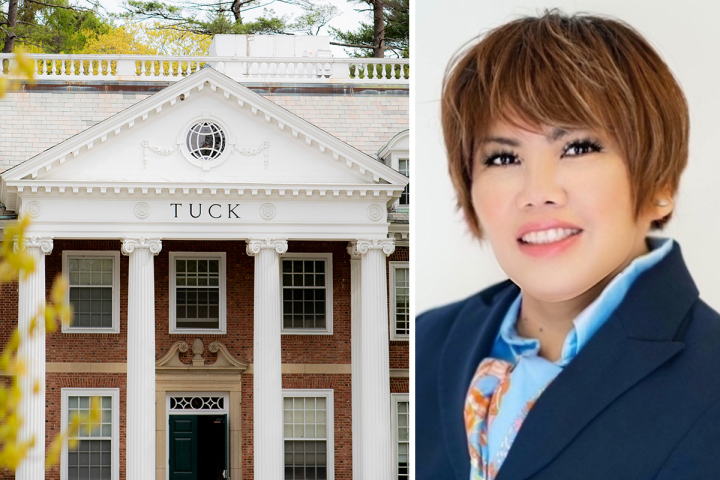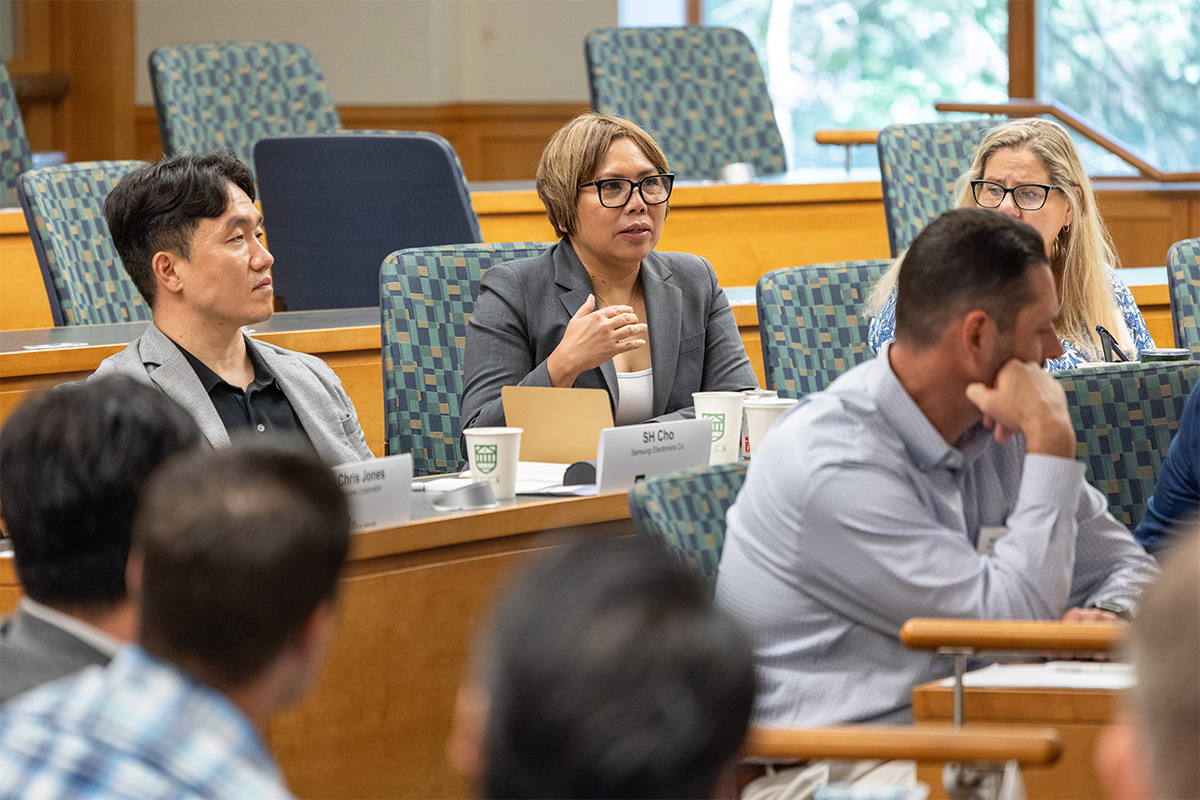By Tuck Communications
19 May 2025

As a seasoned health care leader and new board member for a nonprofit primary care clinic in Ontario, Raquel Legaspi-Labuntog TEE’24 is tackling the dual challenges of system-wide innovation and resource constraints.
Drawing on her experience from Tuck’s Advanced Management Program (AMP), she reflects on the leadership frameworks that continue to guide her—especially in balancing core business priorities with the need for strategic evolution. In this conversation, Raquel shares her top takeaways from AMP, her approach to fostering innovation, and how leading with empathy and adaptability drives her success.
ON MY MIND
What’s top of mind for you right now? What issue(s) are you trying to solve?
I recently took on a new role as a board member for a nonprofit and government-funded primary care clinic in Ontario. Unlike the U.S., Canada has not fully embraced the advantages of using these clinics to address the shortage of primary care physicians. In 2025, my focus as a board member is threefold:
- Reviewing Strategic Direction: Updating our long-term strategy to ensure it effectively addresses health care needs, particularly the pressure on hospital beds in Ontario.
- Aligning with Government Priorities: Navigating funding challenges while guiding my fellow board members, leveraging my health care background and experience in funding.
- Supporting Clinic Growth and Sustainability: Exploring new opportunities for growth and expansion to ease the burden on our health care system, focusing on health promotion and preventing avoidable hospitalizations.
ON LEADERSHIP
How would you describe your personal leadership style?
My leadership style is adaptive and people-centered. I tailor my approach based on the person and the situation. In times of crisis, I am decisive and direct. In day-to-day operations, I foster collaboration, valuing my team's ideas and contributions to build a culture of trust and innovation. I am empathetic and strive to create an environment where people feel valued, heard, and supported. At the same time, I am results-oriented, recognizing when timely decisions are necessary and avoiding paralysis by indecision.
How do you make time for innovation? How can leaders foster a culture of innovation?
Innovation requires intentionality. Leaders must carve out dedicated time and resources for brainstorming, experimentation, and pilot projects. Innovation cannot thrive when treated as a side task. At my organization, I advocate for allocating teams and resources specifically for innovation initiatives, not borrowed from other priorities. Equally important is fostering a culture where creativity is valued, and failure is seen as a learning opportunity. Recognizing and celebrating contributions—big or small—reinforces innovation as an ongoing priority.
What advice do you have for leaders looking to transition into an executive role?
Transitioning to an executive role requires shifting from operational management to strategic leadership. One of my professors at Tuck, Ron Adner, emphasized understanding the broader ecosystem—recognizing that today’s partners could become tomorrow’s competitors. Vijay Govindarajan taught us to challenge the status quo and prioritize innovation, while Pino Audia stressed the importance of building networks and navigating complex systems. Paul Argenti’s lessons on communication underscored the need for clarity and transparency. These insights have been invaluable in shaping my executive leadership approach.
“Being too comfortable with existing success can hinder progress and prevent a company from seizing new opportunities. The ability to innovate and anticipate future trends is crucial for long-term sustainability.”
ON TUCK EXECUTIVE EDUCATION AT DARTMOUTH
What were your top takeaways from your Advanced Management Program experience at Tuck?
AMP provided me with invaluable frameworks to balance innovation with sustaining core business operations. I learned that being too comfortable with existing success can hinder progress and prevent an organization from seizing new opportunities. Regularly assessing the external ecosystem, identifying threats and opportunities, and leveraging partnerships are key to long-term sustainability. Another essential takeaway was mastering crisis communication—navigating uncertainty with clarity, transparency, and empathy.
Tell us about an unexpected challenge or “aha” moment you had during AMP.
Three moments stand out. First, the Three Box Solution framework from Professor Vijay Govindarajan helped me understand the importance of balancing present operations, future innovation, and letting go of outdated practices. Second, I discovered the power of storytelling in leadership—how connecting through narratives can inspire and mobilize teams. Third, I deepened my understanding of power and influence, learning how to build alliances and secure support for strategic initiatives through collaboration and relationship-building.
Are there any lessons from AMP you’ve been able to integrate into your current role?
AMP taught me to adopt both a macro and micro view of my organization—understanding the broader external ecosystem while staying attuned to internal dynamics. This has helped me identify stakeholders, leverage partnerships, and launch collaborative projects. I’ve also embraced creativity as a leadership tool, using it to drive innovation and motivate my team.
How has AMP influenced your approach to team dynamics and decision-making?
I now prioritize inclusivity and collaboration, ensuring diverse perspectives are heard and valued. This fosters a sense of ownership and alignment with organizational goals. By creating an environment where every team member feels empowered, I’ve seen improved team dynamics and more effective decision-making.
Tell us about your Management Action Plan (MAP). Why does it matter for leaders to develop one?
Developing a MAP requires leaders to take a strategic, thoughtful approach to driving organizational success. For me, this process involved revisiting our mission, vision, and values, and recognizing that success is a collective effort. It challenged me to question the status quo, think beyond traditional limits, and explore bold solutions. A well-crafted MAP ensures that decisions are not only strategic but also foster a thriving, engaged workforce.

During the Advanced Management Program—offered by Dartmouth’s top-ranked Tuck School of Business—participants take rigorous courses with Tuck’s renowned faculty on topics ranging from implementing change in your organization to navigating disruptive technologies. | Pictured: Raquel Legaspi-Labuntog participating in AMP cohort activities. | Photo by Rob Strong
ON MOTIVATION AND INSPIRATION
What are you currently reading?
I’m revisiting Vijay Govindarajan’s book, The Three-Box Solution. It remains one of my favorite leadership resources, providing a clear framework for balancing current operations, phasing out outdated practices, and driving future innovation.
How do you foster good mental health and wellness?
I enjoy unplugging through travel and nature. The beach is my favorite place to relax—the sound of the waves and the vastness of the ocean help me reset and refocus. When travel isn’t possible, listening to soothing nature sounds provides a similar sense of calm and balance.
Who inspires you?
My husband and children are my greatest inspirations. They keep me grounded and motivated to lead with purpose and integrity.
“You manage things; you lead people.”
Is there a quote or mantra you live by?
“You manage things; you lead people.” This mantra reminds me to prioritize people over processes. Leadership is about inspiring and developing individuals, fostering trust, and guiding teams toward a shared vision.
What cause are you most passionate about, and why?
Health care accessibility and equity are deeply important to me. Access to quality health care is a basic human right, yet many still lack it. My work and volunteer efforts are focused on bridging these gaps and ensuring equitable access for all.
What nonprofit organizations or charities do you support, and why?
I support a mental health association that serves immigrants struggling to adapt to new cultures. As an immigrant myself, I understand the challenges of adjusting to a new country and the mental health toll it can take. Supporting this cause gives me a sense of purpose and allows me to give back to my community.
ON THE FUTURE
What excites you about the future? What concerns you?
I’m excited about the limitless opportunities for growth and innovation in health care, particularly with advances in technology and AI. However, I’m deeply concerned about the ongoing workforce shortages, burnout, and the environmental impact of health care waste. The magnitude of these challenges requires global collaboration and collective action.
A passionate and resilient leader, Raquel Legaspi-Labuntog started her career as a registered nurse at the forefront of delivering patient care services. She rose through the ranks, becoming a transformational executive driven by her deep commitment to transform organizations and empower people to reach their fullest potential. Her journey—from clinical practice to her current executive leadership role—reflects the purposeful, bold, and visionary leadership cultivated at Tuck School of Business.
In Tuck Leadership Insights—a series from Tuck Executive Education at Dartmouth’s Tuck School of Business—senior leaders share the business challenges they’re tackling, the innovations impacting their work, and their advice for today’s and tomorrow’s leaders.
